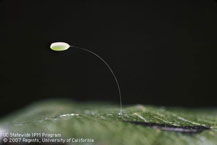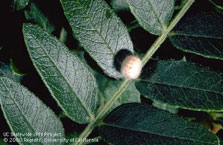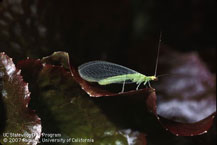home | fall garden | deciduous & conifer garden
Green Lacewing
Green lacewing gets its name from the large lace-like wings it has as an adult. There are many species of green lacewings and they are often hard to tell apart. Green lacewing lives in fields, gardens and forest edges. Known as a beneficial insect, green lacewing larvae are voracious killers of insect pests that often damage plants and vegetables. The adult female lays up to 100 eggs on the underside of a leaf in an aphid colony. After a few days the eggs hatch and tiny predatory larvae emerge ready to feast on the aphids. Often referred to as aphid lions, each lacewing larva will devour 200 or more aphids or aphid eggs in a week during their 2 to 3 week developmental period. Larvae also feed on other pests such as thrips, spider mites, and mealybugs. Larvae of the green lacewing then pupate in a cocoon for around 5 days. Once hatched, adults feed on nectar, pollen and honeydew in order to stimulate their reproductive process. Green lacewing adults are characterized by wide, long, and delicate wings. Their bodies are usually bright green to greenish-brown. So, if you see one in your garden, do not kill it because it will help your garden grow by killing pests in it.
 |
 |
 |
 |
